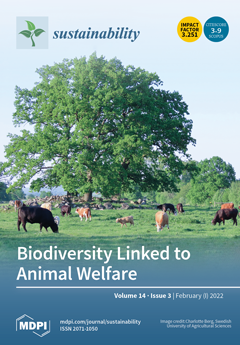We studied the impact of the neophyte tree
Fraxinus pennsylvanica on the diversity of beetles in floodplain forests along the river Elbe in Germany in 2016, 2017 and in 2020, where 80% of all
Fraxinus excelsior trees had died following severe droughts. Beetles
[...] Read more.
We studied the impact of the neophyte tree
Fraxinus pennsylvanica on the diversity of beetles in floodplain forests along the river Elbe in Germany in 2016, 2017 and in 2020, where 80% of all
Fraxinus excelsior trees had died following severe droughts. Beetles were collected by insecticidal knock-down from 121 trees (64
F. excelsior and 57
F. pennsylvanica) and identified to 547 species in 15,214 specimens. The trees sampled in 2016 and 2017 showed no signs of drought stress or ash dieback and serve as a reference for the comparison with the 2020 fauna. The data proved that
F. excelsior harbours the most diverse beetle community, which differed also significantly in guild composition from
F. pennsylvanica. Triggered by extremely dry and long summer seasons, the 2020 ash dieback had profound and forest-wide impacts. Several endangered, red-listed beetle species of Saxonia Anhalt had increased in numbers and became secondary pests on
F. excelsior. Diversity decreased whilst numbers of xylobionts increased on all trees, reaching 78% on
F. excelsior. Proportions of xylobionts remained constant on
F. pennsylvanica. Phytophages were almost absent from all trees, but mycetophages increased on
F. pennsylvanica. Our data suggest that as a result of the dieback of
F. excelsior the neophyte
F. pennsylvanica might become a rescue species for the European Ash fauna, as it provides the second-best habitat. We show how difficult it is to assess the dynamics and the ecological impact of neophytes, especially under conditions similar to those projected by climate change models. The diversity and abundance of canopy arthropods demonstrates their importance in understanding forest functions and maintenance of ecosystem services, illustrating that their consideration is essential for forest adaptation to climate change.
Full article





